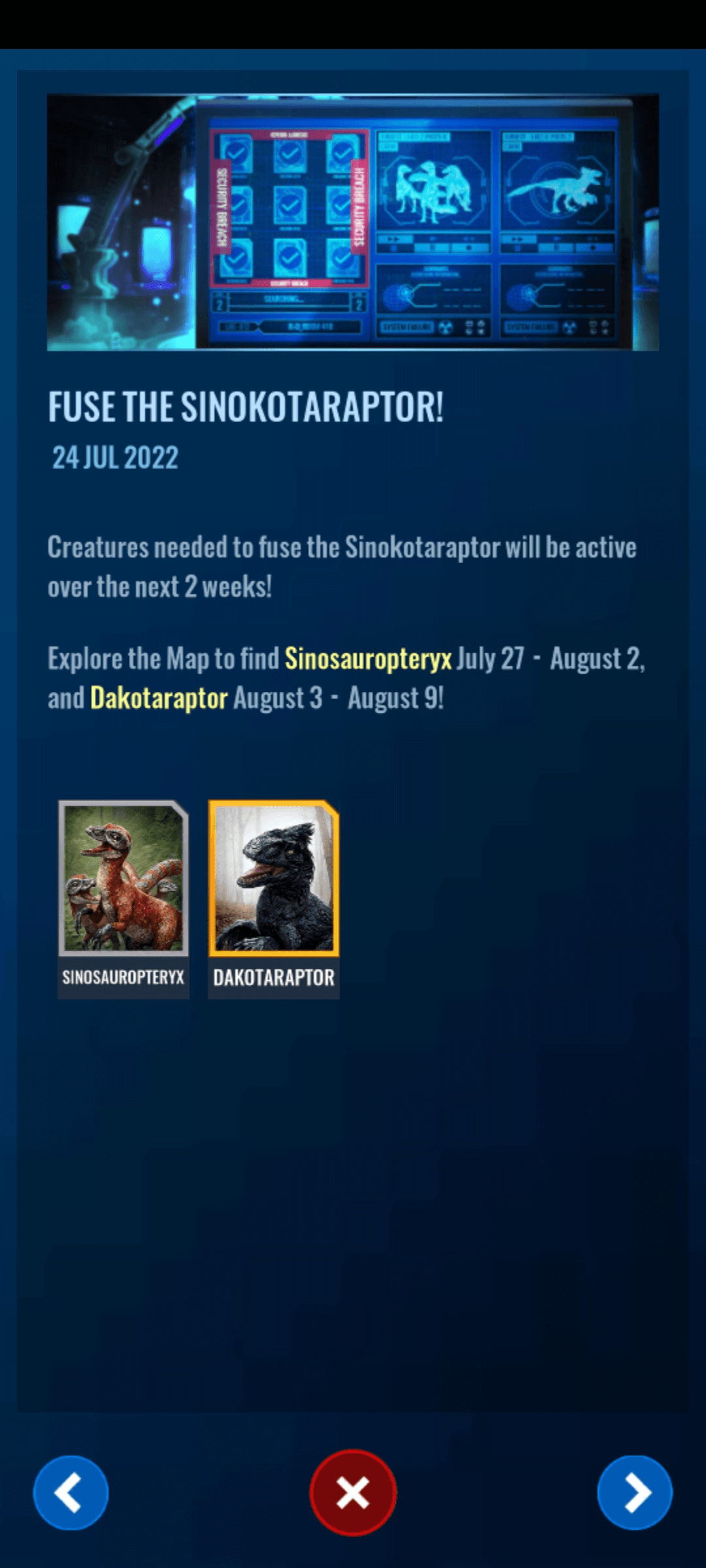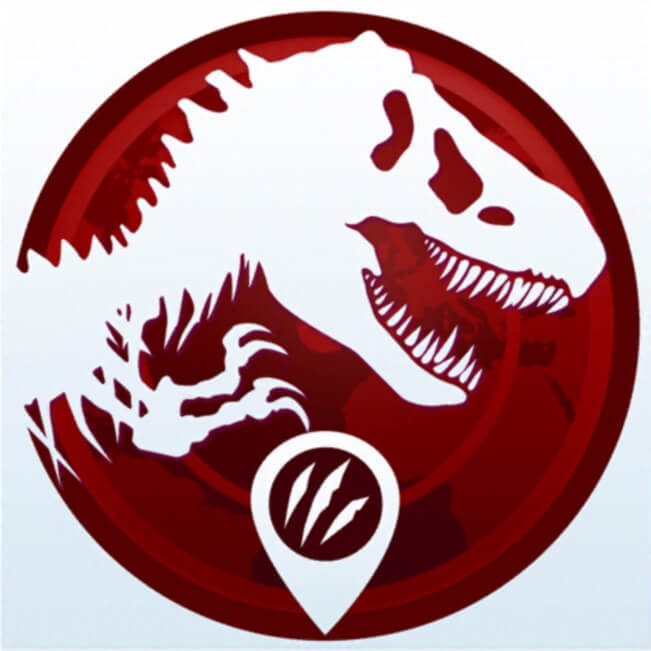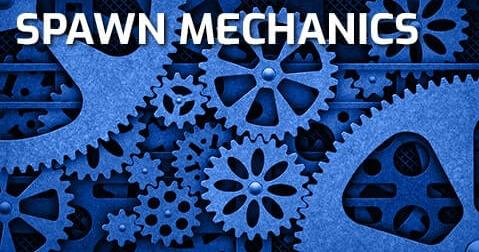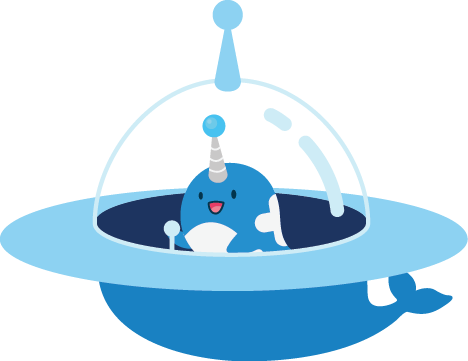Spawn Mechanics/Nests and Where To Find Dinosaurs
(Last Updated September 6, 2022)
Below are the various ways creatures spawn in Jurassic World Alive, as well as an image showing what those spawns look like now. Any changes to zones are noted in italics. Zones rotate on the first Monday of every month. This means the local zone you are in right now will be different next month. They also rotate in a pattern. They will go 1>2>3>4>1. As of right now, continental creatures do not rotate and park spawns will not rotate either.
This is effective as of Patch 2.18
Oviraptor Gen 2 - Local 2 Day/Dawn/Dusk
Brachiosaurus - Moved from Exclusive to Local 3 Day/Dawn/Dusk
Quetzalcoatlus Gen 2 - Local 3 Night/Dawn/Dusk
Troodon - Removed from Dusk Pool (Day/Dawn only)
Red - Short Range Global (best odds at Day/Dusk)
Moros Intrepidus - Exclusive
Short-Range Spawns
The Map now differentiates short-range and long-range spawn points and will spawn different creatures
Some creatures will only be found short-range. With this new differentiation, short-range will have a slightly higher chance of spawning an Epic creature compared to long-range spawn points.
- Locations and creatures you can see when very close (within 30 meters, which is the smaller blue circle radar on your map) are considered to be short-range.
- Locations and creatures you see out of the blue circle radar on your map are considered long-range.
- Scent Capsules are great and bring creatures that are out of reach to you! Because creatures that are considered short-range are within your reach, scent capsules are not effective for short-range creatures and will not spawn short-range exclusive creatures.
Global Spawns
Global spawns are dinosaurs that spawn all across the world of Jurassic World Alive. There are four different map settings based on the time of day for all spawns:
- Anytime - Creatures in this category will spawn in their location no matter the time of day.
- Daytime - Creatures in this category spawn just when the map is in "daytime mode" as well as "dusk/dawn" mode, based on the local timezone. Generally Daytime is around an hour after sunrise and around an hour before sunset. So longer daylight hours mean you'll get more daytime and anytime spawns.
- Nighttime - Creatures in this category are night hunters or feeders, and only spawn when the map is in "nighttime mode" as well as "dusk/dawn" mode, about an hour after local sunset until about an hour prior to local sunrise. Longer nighttime hours mean you'll get more nighttime spawns and anytime spawns.
- Dusk/Dawn - Creatures in this category are present only in that 2-hour span between night/day cycles and day/night cycles. Dawn and Dusk usually starts about 45 minutes to an hour before the local sunset and sunrise time. Dusk/Dawn only creatures will only spawn in this time period, but this time is also the most congested with spawns as everything else is also spawning at this time.
So a Global Daytime creature will spawn anywhere on the map only in Daylight hours, and a creature marked as Day/Dawn/Dusk will appear during Daylight hours, as well as Dawn/Dusk hours.
Short Range vs. Long-Range Spawns
The Map now differentiates short-range and long-range spawn points and will spawn different creatures
- Locations and creatures you can see when very close (within 30 meters, which is the smaller blue circle radar on your map) are considered to be short-range. They will only appear when you get within range of them.
- Locations and creatures you see out of the blue circle radar on your map are considered long-range.
- You might see creatures as both short-range and long-range but there are short-range exclusive creatures that will only spawn within your circle.
Short-Range Exclusive
In 2.4, short-range exclusive creatures were introduced. These creatures will only spawn within the short-range circle. Short-range exclusive creatures are all global anytime and are indicated with an asterisk in the list and with an icon on the images below. Scent capsules are not effective for short-range proximity, exclusive creatures.
Continental Creatures
In 2.6, continental creatures were introduced. These epic creatures are global anytime, but can only be found on their specific continents. If you are not on the continent something specific spawns, you will need to unlock it or get DNA through sanctuaries or events and incubators.
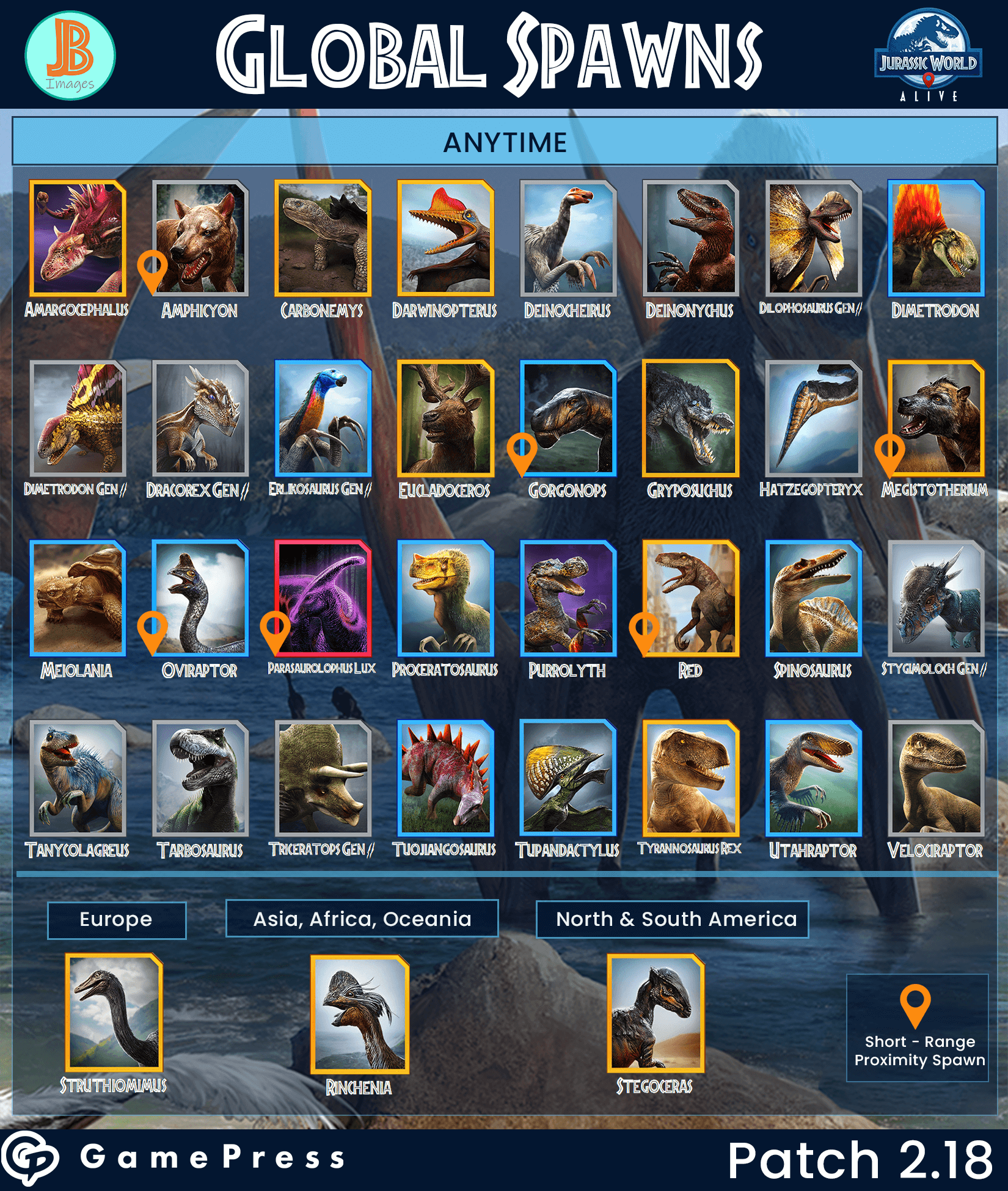
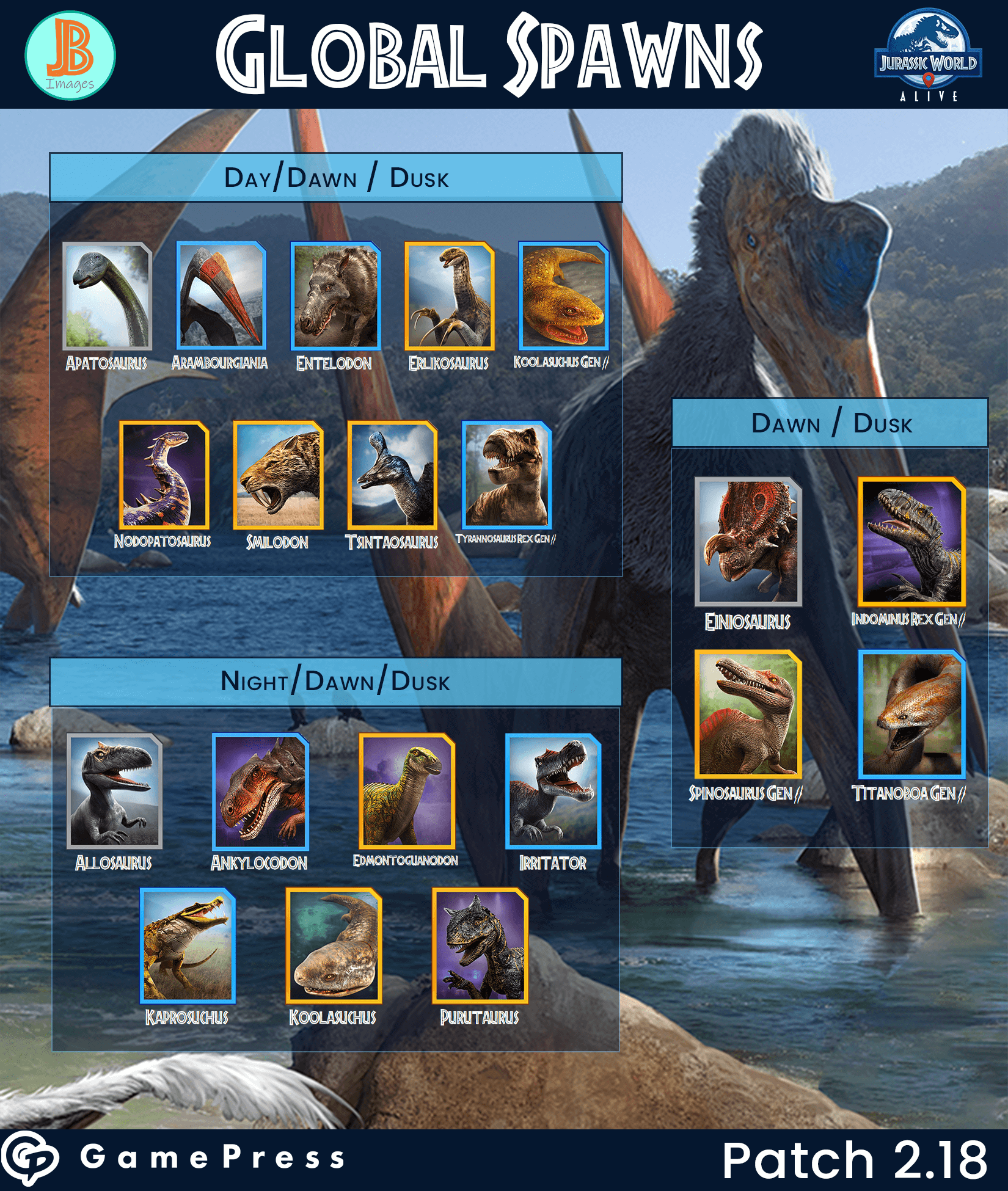
Anytime
Legendary
Parasaurolophus Lux*
Epics
Amargocephalus
Carbonemys
Darwinopterus
Eucladoceros
Gryposuchus
Megistotherium*
Red*
Tyrannosaurus Rex
Rares
Dimetrodon
Erlikosaurus Gen 2
Gorgonops*
Meiolania
Oviraptor*
Proceratosaurus
Purrolyth
Spinosaurus
Tuojiangosaurus
Tupandactylus
Utahraptor
Common
Amphicyon*
Deinocheirus
Deinonychus
Dilophosaurus Gen 2
Dimetrodon Gen 2
Dracorex Gen 2
Hatzegopteryx
Stygimoloch Gen 2
Tanycolagreus
Tarbosaurus
Triceratops Gen 2
Velociraptor
*short-range only
Continental Exclusive
Struthiomimus - Europe
Rinchenia - Asia, Africa, Oceania
Stegoceras - North & South America
Day/Dawn/Dusk
Epics
Erlikosaurus
Smilodon
Nodopatosaurus
Rares
Arambourgiania
Entelodon
Koolasuchus Gen 2
Tyrannosaurus Gen 2
Commons
Apatosaurus
Dawn/Dusk
Epic
Spinosaurus Gen 2
Indominus Rex Gen 2
Rares
Titanoboa Gen 2
Commons
Einiosaurus
Dawn/Dusk/Night
Epics
Edmontoguanodon
Purutaurus
Koolasuchus
Rares
Irritator
Kaprosuchus
Ankylocodon
Local Spawns
Local spawns are also broken out into Day, Dawn/Dusk, and Night cycles, but unlike Global Spawns, they only appear in certain places.
Each local is approximately 5 to 10 square blocks (varying widely depending on where you're living) but they are broken out in a grid that spans city and country alike. So if you're seeing a lot of Paralophosaurus, driving a few blocks in any direction should get you to a different set of dinosaurs.
Worry not, you do not need to wander aimlessly in some direction in hopes of finding the zone you seek. Thanks to the help of our discord member, Kelociraptor, we found there is a method to the madness. The zones are laid out in a pattern, so once you figure out what you are currently in, it should be easy to figure out how to find any of the others from where you are at. The pattern is quite simple. North/South, they run 1-2-3-4. Your JWA Gamepress staff has found the specific direction can vary, so it may take a little trial & error to recognize which direction it runs in your location. For example, in Phoenix, they run 1 through 4, North to South. In Cincinnati, we’ve found they run the opposite but still follow the 1, 2, 3, 4 order. East/West, they alternate either 1/3 or 2/4.
This is important for rare and epic creatures, because locals are a consistent way to go "hunting" for a specific creature that you need.
There is no way in game to identify which local you are in, but thankfully there is an easy way to figure it out yourself. Take a look at what common dinosaurs are spawning around you, and find one of the commons on the grid below to figure out which local you are in. And since locals divide (usually) at roads, you can generally tell where the change occurs and a new local begins.
Scents also pull heavily from the local pool so knowing what could spawn around you can be very helpful to figuring out what scent you should be using to target a specific creature.
Below are the locals we have now:
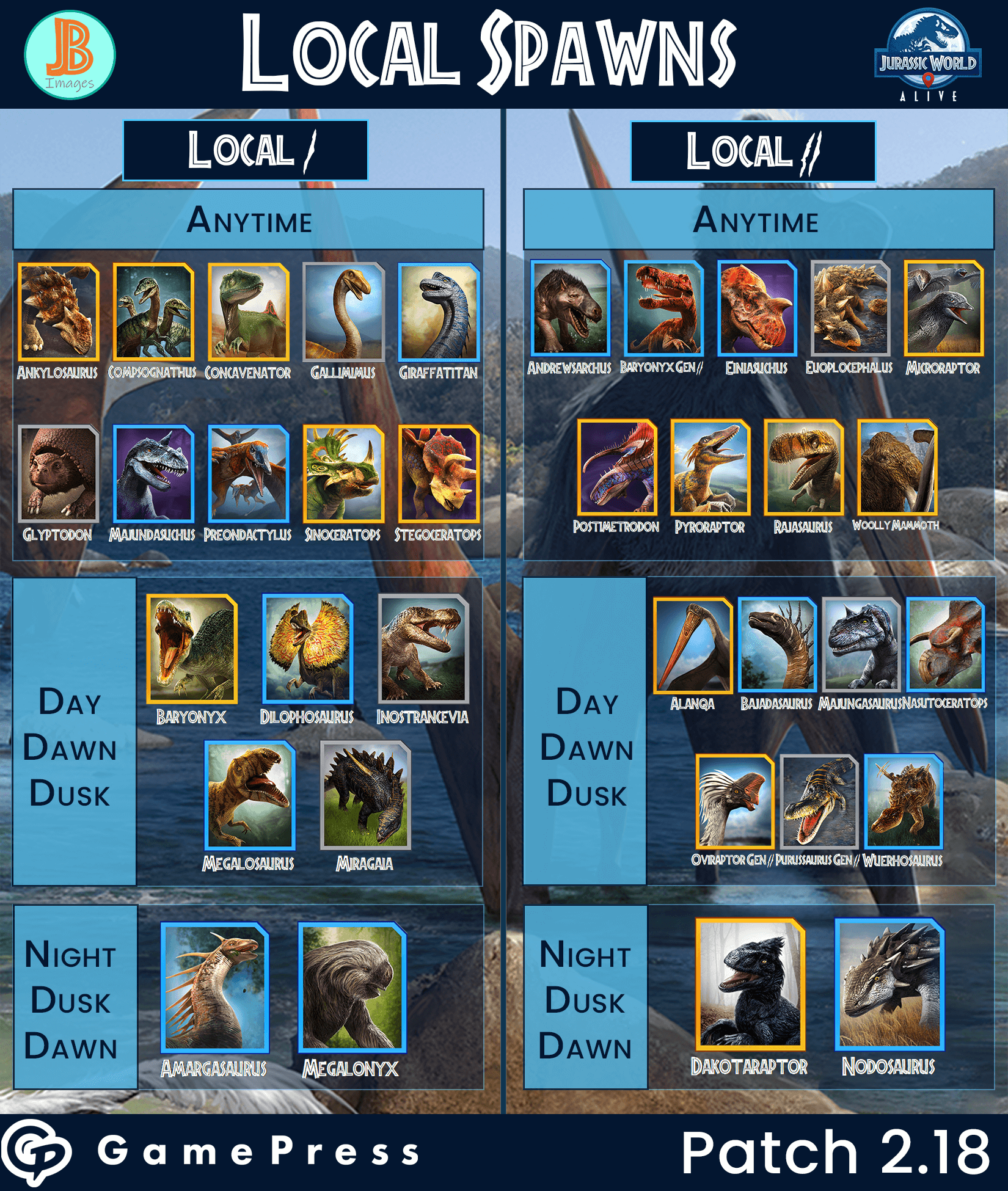
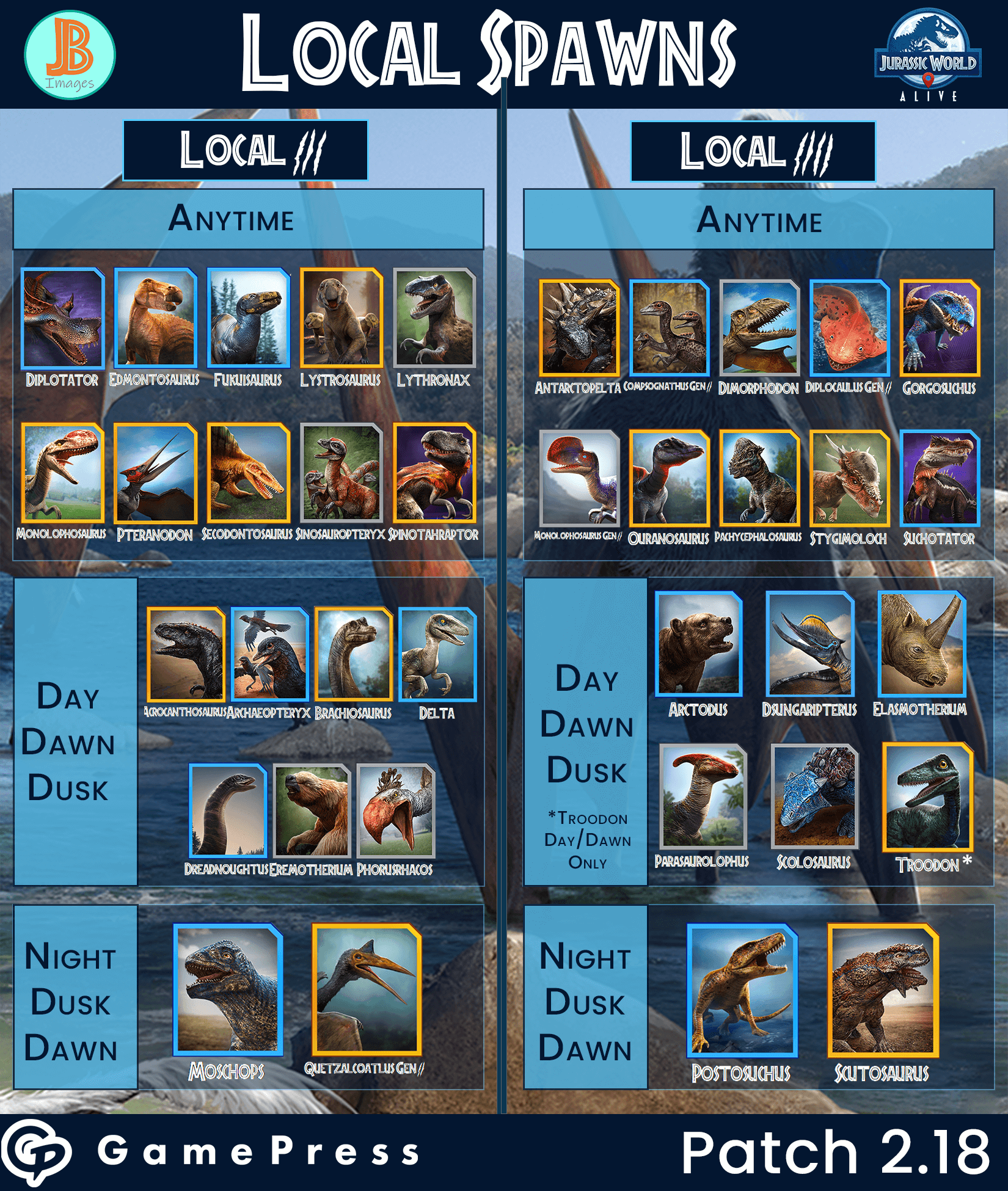
Local 1 Spawns
Anytime
Epics
Ankylosaurus
Compsognathus
Concavenator
Sinoceratops
Stegoceratops
Rares
Preondactylus
Majundasuchus
Giraffatitan
Common
Gallimimus
Glyptodon
Day/Dawn/Dusk
Common
Inostrancevia
Miragaia
Rares
Megalosaurus
Dilophosaurus
Epics
Baryonyx
Dawn/Dusk/Night
Rares
Amargasaurus
Megalonyx
Local 2 Spawns
Anytime
Epic
Postimetrodon
Pyroraptor
Rajasaurus
Woolly Mammoth
Microraptor
Rare
Andrewsarchus
Baryonyx Gen 2
Einiasuchus
Common
Euoplocephalus
Day/Dawn/Dusk
Rares
Bajadasaurus
Nasutoceratops
Wuerhosaurus
Common
Majungasaurus
Purussaurus Gen 2
Epics
Alanqa
Oviraptor Gen 2
Dawn/Dusk/Night
Rare
Nodosaurus
Epic
Dakotaraptor
Local 3 Spawns
Anytime
Epics
Lystrosaurus
Monolophosaurus
Pteranodon
Secodontosaurus
Spinotahraptor
Rares
Diplotator
Edmontosaurus
Fukuisaurus
Commons
Lythronax
Sinosauropteryx
Day/Dawn/Dusk
Common
Eremotherium
Phorusrhacos
Rare
Delta
Dreadnoughtus
Archaeopteryx
Epic
Acrocanthosaurus
Brachiosaurus
Dawn/Dusk/Night
Rare
Moschops
Epic
Quetzalcoatlus Gen 2
Local 4 Spawns
Anytime
Epics
Antarctopelta
Gorgosuchus
Ouranosaurus
Pachycephalosaurus
Stygimoloch
Rare
Compsognathus Gen 2
Diplocaulus Gen 2
Suchotator
Commons
Dimorphodon
Monolophosaurus Gen 2
Day/Dawn
Epic
Troodon
Day/Dawn/Dusk
Rare
Arctodus
Dsungaripterus
Elasmotherium
Common
Parasaurolophus
Scolosaurus
Dawn/Dusk/Night
Epic
Scutosaurus
Rare
Postosuchus
Park Spawns
Parks function as another local with its own rules. Instead of being a large area, parks lie on top of locals anywhere on your map where the ground is green (well for the most part). In 1.11 we have seen more "hidden parks" pop up where there is not any green on the map but the area spawns park dinos. Parks also have a local as well so if you run a scent in a park in Local 1 you will have a chance to spawn either set of creatures.
These are generally... well... parks -- but they could be all sorts of other types of naturalesque locations. Parks also generally contain a much higher percentage of Special Event Supply Drops (the green ones) which also means most parks have lots of featured dinosaurs as well.
After patch 1.7, many park dinosaurs were moved to the new daily dinosaur feature -- which was excellent as parks were getting very crowded and it was getting very hard to find anything consistently in a park. Let alone, parks were not easy for all players to find.
Below is the remaining list of park dinosaurs:
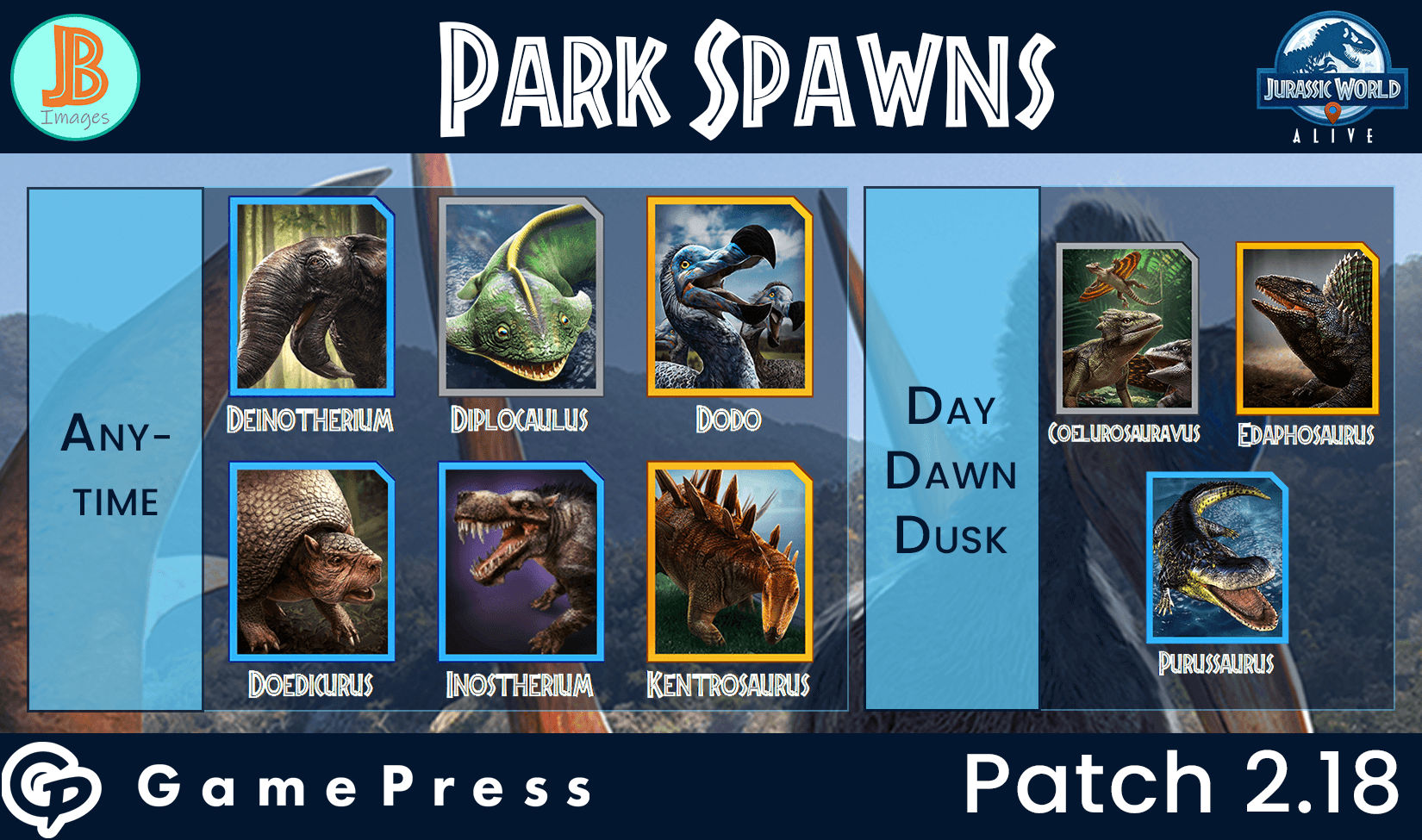
Anytime
Epics
Dodo
Kentrosaurus
Rare
Deinotherium
Doedicurus
Inostherium
Common
Diplocaulus
Day/Dawn/Dusk
Epic
Edaphosaurus
Rare
Purussaurus
Common
Coelurosauravus
Daily Dinosaurs
Daily Dinosaurs was a new feature introduced in patch 1.7. Any creature in the daily category is available globally (and during day, dawn/dusk and night cycles) but only during certain days of the week.
Each day, you will see a common and a rare creature spawning for that day. Epic daily dinos were removed in patch 1.12 and distributed throughout the various locals or went global. This may change as time goes on, but for now daily dinosaurs are grouped in sets like this.
You'll know a creature is a daily dinosaur by looking at the created dinosaur in the lab. Scrolling down you'll see it identifies "Active Times" and shows which day you'll see that dinosaur.
It is worth noting, at the moment, that daily dinosaurs do not spawn when you use scents. This may change as well but for now they are not on the scent tables.
Monday
Archaeotherium
Argentinosaurus
Tuesday
Ankylosaurus Gen 2
Megaloceros
Wednesday
Ophiacodon
Haast Eagle Gen 2
Thursday
Nundasuchus
Gorgosaurus
Friday
Iguanodon
Carnotaurus
Saturday
Stegosaurus
Echo
Sunday
Irritator Gen 2
Triceratops
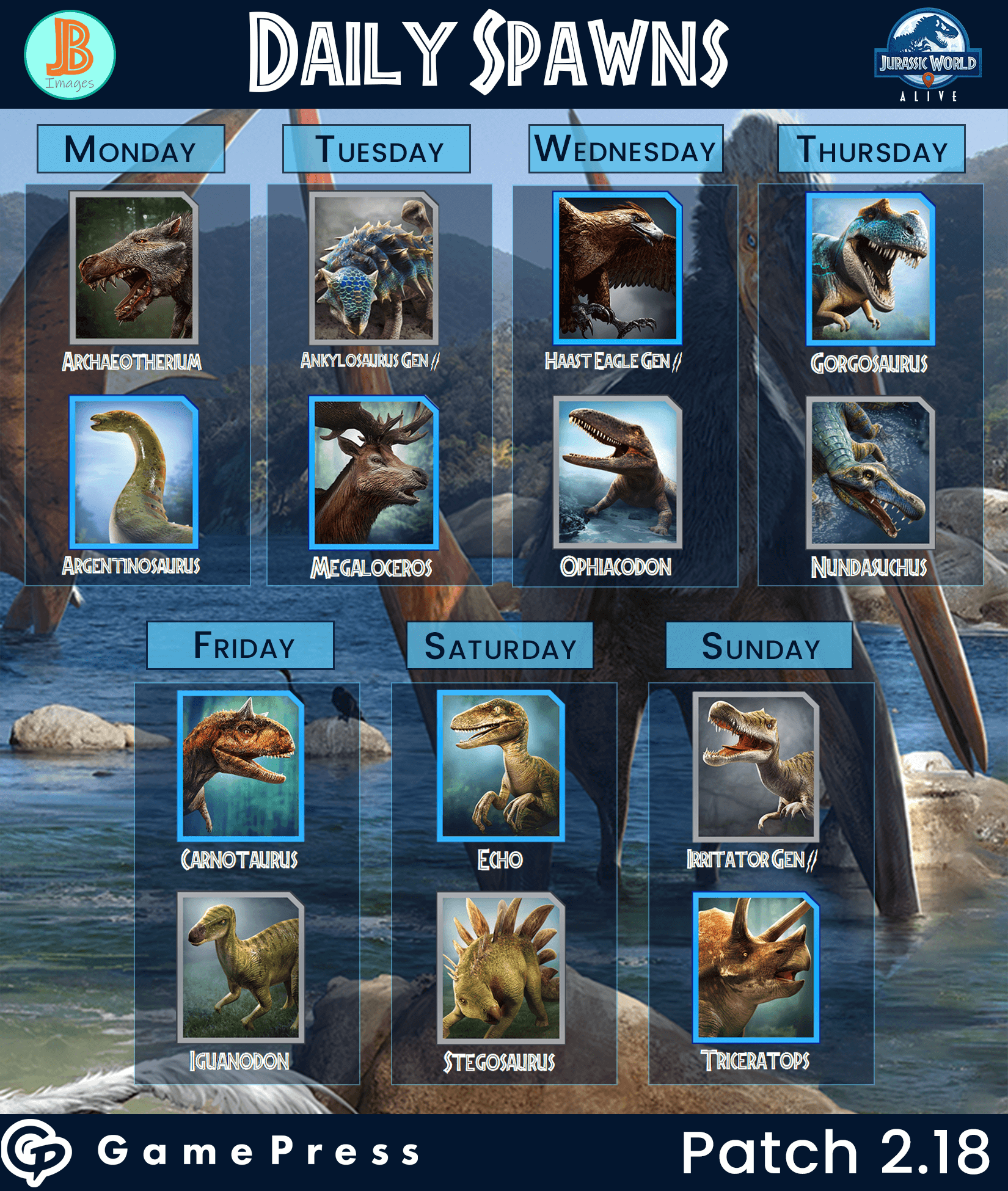
Event Exclusive and Battle Exclusive Dinosaurs
All these dinosaurs are not able to be found in the wild. Either they are locked behind the Arena Incubator, or behind Events Ludia releases. They are the following:
Event Exclusives:
Epics:
- Ailurarctos
- Allosaurus G2
- Beta
- Blue
- Bumpy
- Diplodocus
- Ghost
- Moros Intrepidus
- Sonorasaurus
- Titanoboa
- Woolly Rhino
- Giganotosaurus
Rares:
- Albertosaurus
- Arctops
- Argentavis
- Cervalces
- Dracorex
- Kelenken
- Quetzalcoatlus
- Tenontosaurus
- Therizinosaurus
Battle Exclusives:
- Fallen Kingdom: Charlie
- Mt. Sibo: Suchomimus
- S. S. Arcadia: Marsupial Lion
- Nublar Jungle: Haast Eagle
- Badlands: Sarcosuchus
- Lockdown: Scaphognathus
- Sorna Marshes: Maiasaura
- Jurassic Ruins: Brontotherium
- Lockwood Estate: Ornithomimus
- Aviary: Ghost
Nests
Nests do exist in Jurassic World Alive, but they work a bit differently than nests in something like Pokemon Go. Rather than a large area where a certain creature can spawn, a nest in Jurassic World Alive is a single spawn point that has a chance of spawning a nest dino in addition to the chance of spawning a local, global, or daily dino.
Nests are usually points on a map google might find, like a law office, a bus stop, a fire station, etc. While they provide a great mix of other dinosaurs, they aren't quite as reliable a source of finding a specific dinosaur as a local would be.
In Patch 1.10 the chances of seeing a nest dino increased significantly. These dinos can't be attracted by scents. It's also important to note that not all gas stations, for example, will have nest spawns and we have not been able to determine how nests are actually determined in-game.
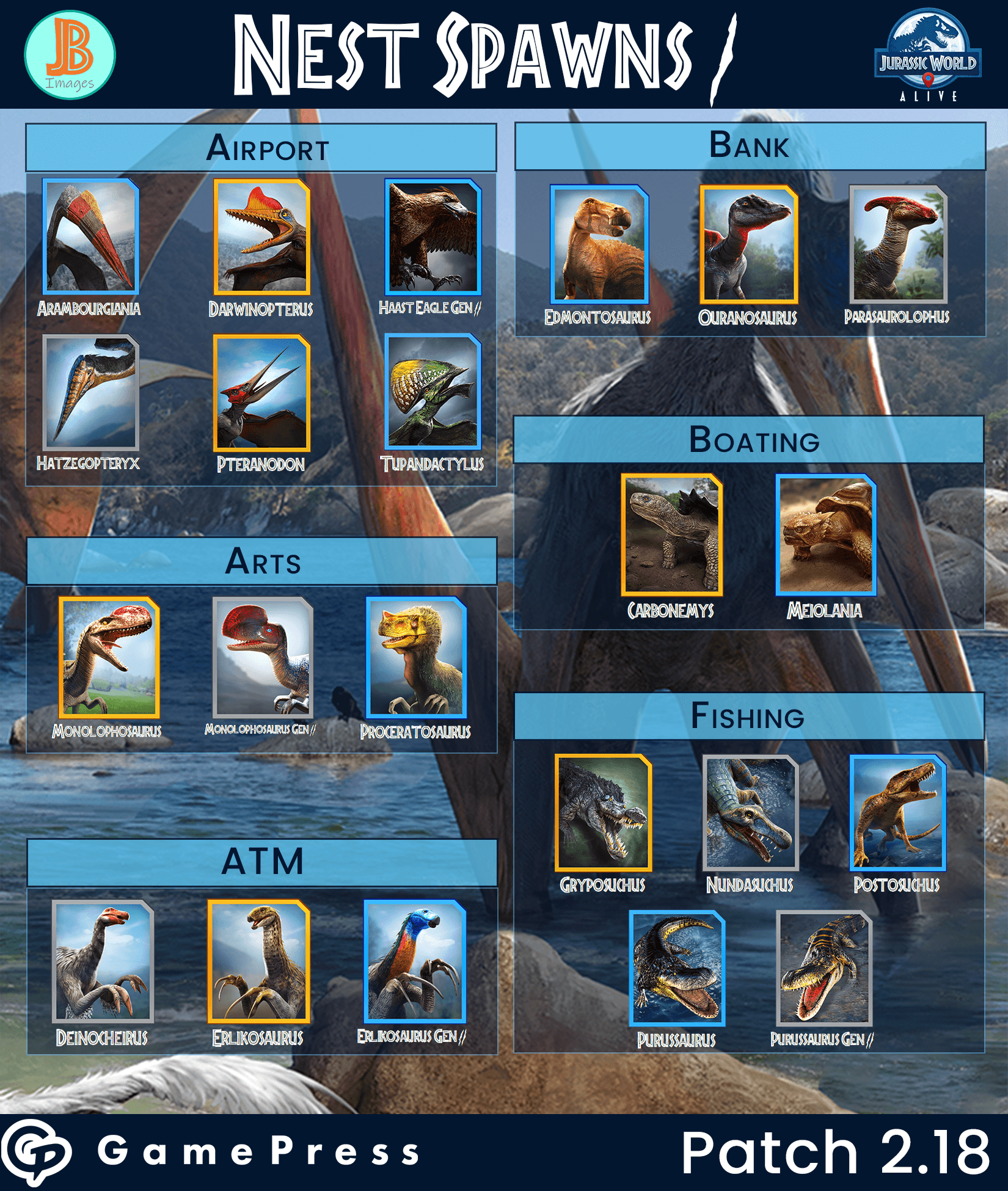
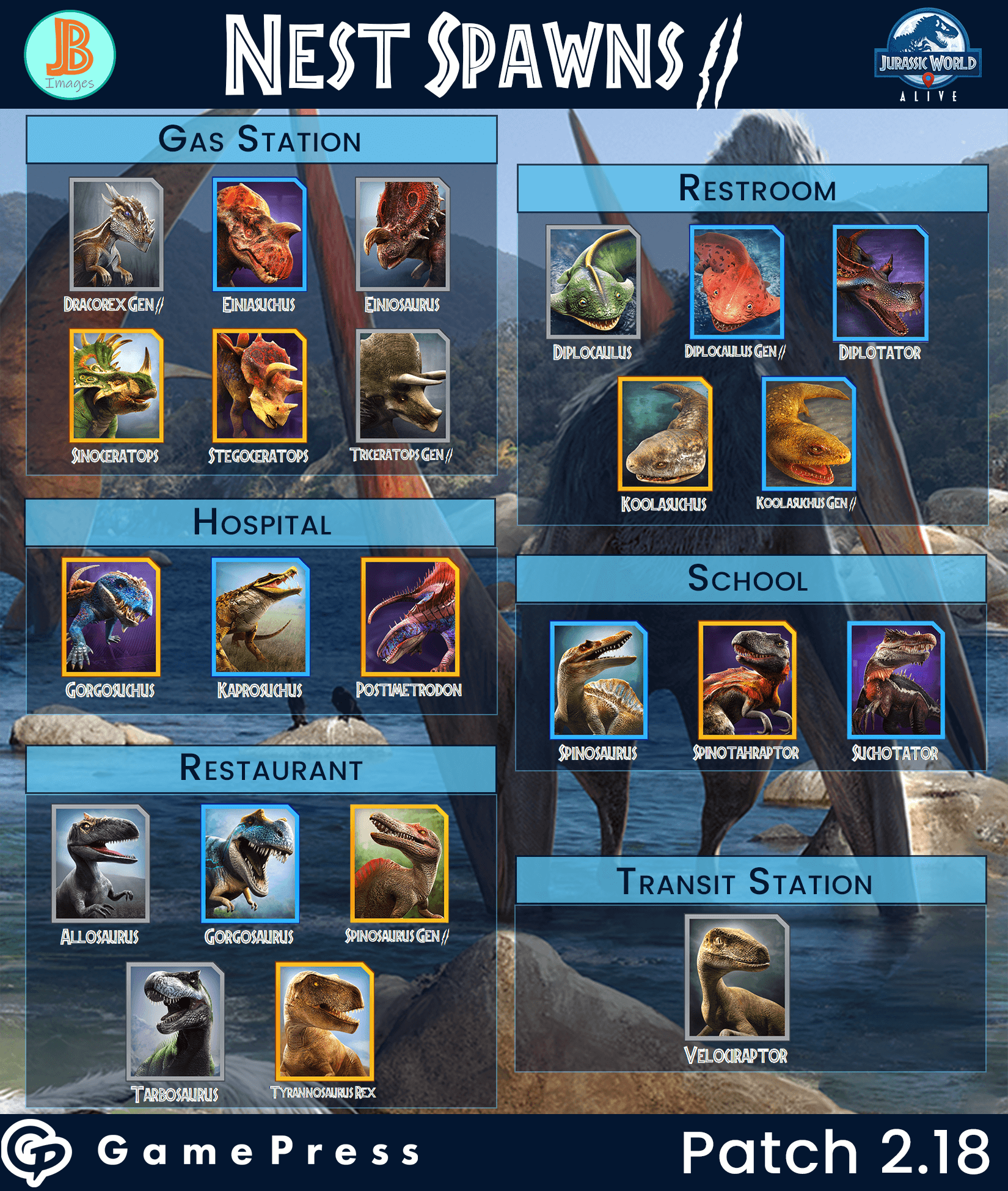
Hybrid Pursuit
In addition to the creatures that are listed above, every week there is a featured creature as part of a hybrid pursuit. The hybrid pursuits go in order of the patch that new creatures are released.
Each week, a different component for a hybrid is announced via the official Ludia twitter and the in-game news tab and is available as a global spawn. These creatures can be scented even if the featured creature is normally an exclusive spawn.
Below is an example of Hybrid pursuit. We will keep you up to date on our main page with the current hybrid pursuit. Here is a current running list of the hybrid pursuits (in no particular order within each patch).
2.12
Arctovasilas (Current Pursuit)
2.13
Fukuimimus
Albertospinos
Troodoboa
Ankylos lux
2.14
Ankylodactylus
Ardontognathus
2.15
Tarbognathus
Thylaconyx
Albertocevia
Allodrigues
2.16
Lystrosuchus
Dreadactylus
Giganyx
2.17
Segnoraptor
Compsoraptor
2.18
Thylos Intrepidus
Lystrosavis
Indonemys
